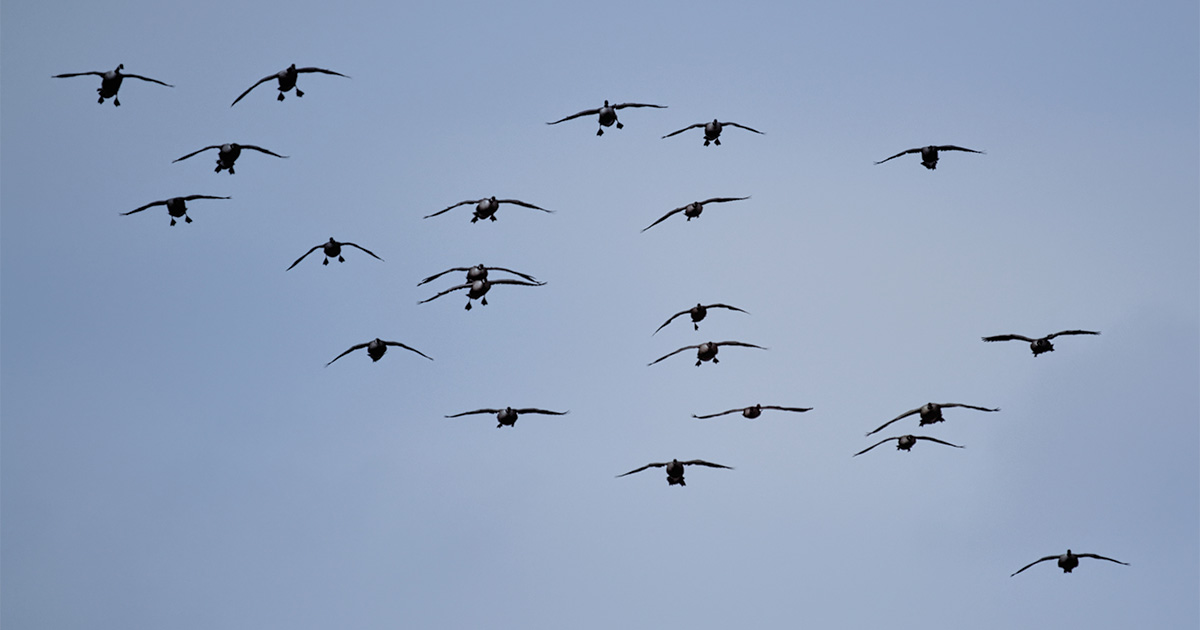First-Chance Geese
Try these specialized tactics for early-season honkers in your area
Try these specialized tactics for early-season honkers in your area


Greg Soulliere, Upper Mississippi River and Great Lakes Joint Venture science coordinator with the US Fish and Wildlife Service, enjoys chasing Canada geese during Michigan's early season, but he doesn't focus on the local population. Instead, he targets migratory flocks returning from molting areas far to the north.
"We refer to resident Canada geese as temperate-nesting giant Canada geese," Soulliere explains. "We do this because we have learned that a large percentage of this population migrates north into Canada, near Hudson Bay, for their annual molt. These are nonbreeding juveniles and failed breeders who lost a nest."
Soulliere pays close attention to early September cold fronts, which often carry these molt migrants back to Michigan, Indiana, Ohio, Wisconsin, and Minnesota. He looks for flocks of 40 to 100 birds cruising roughly 100 to 200 yards off the ground.
"Many of these birds have been far up north for a few months and haven't had much exposure to people, so they are less cautious," Soulliere says. "These molt migrators are easy to identify too, as many times they arrive in the area during mid-morning after traveling all night. That makes them very susceptible to calling and decoys."
Local geese that do spend the summer on their home ranges are familiar with the neighborhood, including other geese in the area. As a result, veteran Indiana goose hunter Jason Kyle downsizes his decoy spread and uses highly realistic decoys to fool savvy local birds. "I handpick my best-looking decoys-fully flocked, full-bodies-this time of year," he explains. "The areas that I hunt are home to a large population of locals. This means we have some educated family groups. Small, high-quality spreads tend to make these local birds more comfortable."
Kyle calls sparingly and relies on being in the right place at the right time to intercept birds where they are actively feeding. "You definitely have to spend time scouting. As always, it really helps to be where the birds want to be," he says.
Field Hudnall, co-owner of Field Proven Calls and a past world goose calling champion, takes a very different approach when hunting early season geese in Kentucky. Rather than hunting the fields where geese feed, he sets up on major rivers and runs traffic on local flocks trading between feeding and loafing areas.
"On big rivers, you have to be in their flight line," Hudnall says. "We put out a lot of decoys and use minimal calling. Geese tend to get loud when they are feeding aggressively, but when they are resting on the water, you hear mostly short clucks and moans. We imitate that and let the decoys do the work."
Hudnall adds that while local geese often get locked into set feeding routines on agricultural fields, trading birds can be easier to fool over water. "They don't expect trouble when they are over big water. Very few hunters are willing to go through the trouble of deploying a large water set this time of year."
While Hudnall keeps relatively quiet when geese are approaching his decoys, there is one situation in which he recommends hammering on the call. "Urban birds in family groups have a tendency to stick together," he says. "So immediately following a volley, my brother and I will get on our calls very aggressively. Sometimes the rest of the flock will turn around and come right back into the decoys. I'd never try that during the regular season, but it can work very well during the first few hunts of the year."
Ducks Unlimited uses cookies to enhance your browsing experience, optimize site functionality, analyze traffic, and deliver personalized advertising through third parties. By continuing to use this site, you agree to our use of cookies. View Privacy Policy